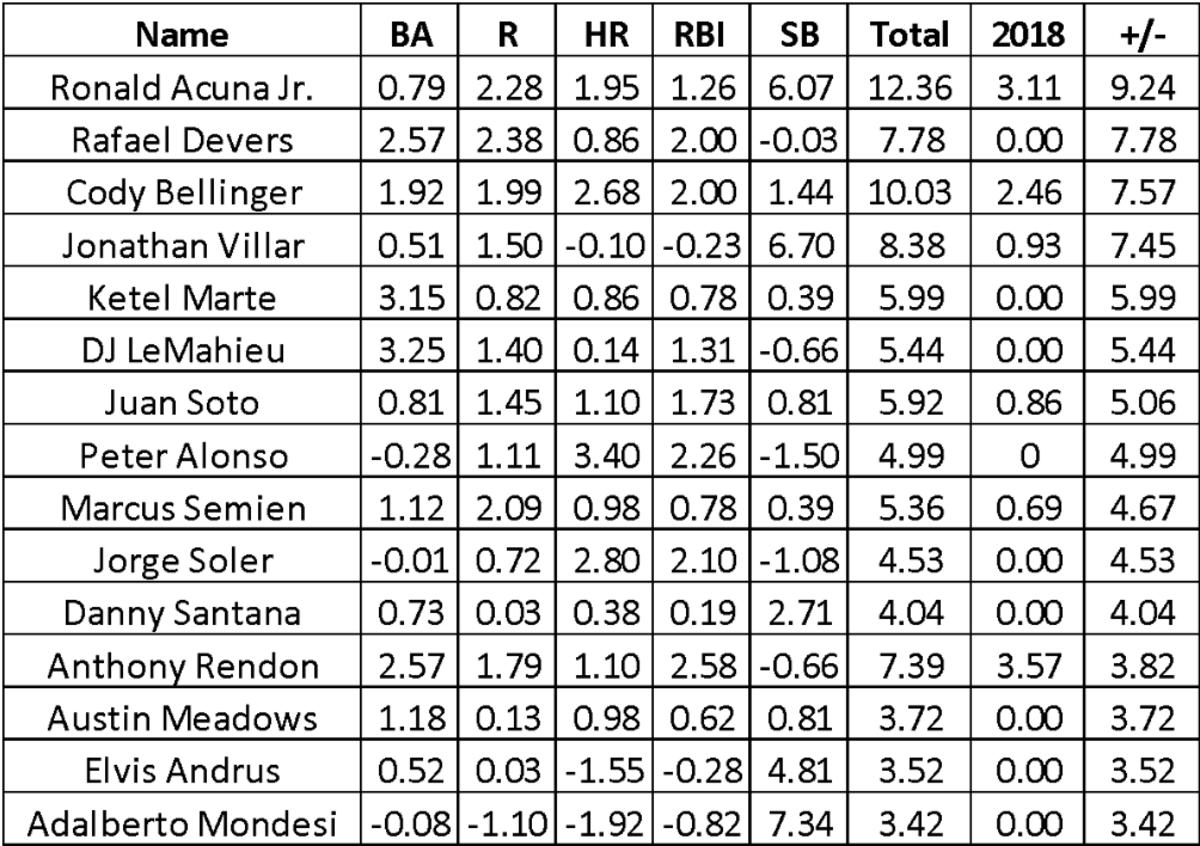Fantasy Baseball's 2020 Breakout Hitter Will Be...

The quest to find the next impact bat in Major League Baseball can come from all different areas of the draft, and the definition of a breakout hitter varies from fantasy site, league format, and league competition. Here’s a look at the top 15 players in SIscore in 2019 based on their growth from 2018 (Note: I set a player’s SIscore from 2018 to 0.00 on the downside to eliminate injured players and players with minimal playing time the previous season):

The top breakout players based on ADP in 2019 were Rafael Devers (148), Jonathan Villar (66), Ketel Marte (206), D.J. LeMahieu (271), Peter Alonso (247), Marcus Semien (212), Jorge Soler (315), Danny Santana (undrafted), and Austin Meadows (179).
I’m looking for a batter that will make a push of a minimum of six rounds in the 2021 draft season. Here are my five top breakout hitter choices in 2020:
OF Kyle Tucker, HOU: Beast upside with questions with his ability to lock down full-time at-bats.
SS Corey Seager, LAD: Still looking to build on his 2016 and 2017 success while missing 164 games over the past two years.
SS Paul DeJong, STL: Power bat with some underlying speed, but his batting average will keep most fantasy players away.
2B Gavin Lux, LAD: Future star with a starting job while needing to hit his way up the batting order for a talented offensive team.
UT Nick Solak, TEX: Possible middle of the order bat with a 20/15 skill set, but he lacks a defined position out of the gate.
My breakout hitter in 2020 is Corey Seager.
The shortstop position is loaded this year in depth and talent, and Seager doesn’t bring the needed speed that most fantasy owners are looking for from the middle infield position. His ADP sits at 153 in 12-team and 151 in 15-team leagues since February 15.
The first question with his value comes from his slot in the batting order. On opening day, it’s a given that Mookie Betts will bat leadoff for the Dodgers while Cody Bellinger lines up as the best option to hit clean up.
If L.A. wants to begin the year with an alternation of righthanded and lefthanded bats, Seager looks to be in the mix to hit second or fifth in the batting order with Max Muncy being his most prominent threat to bat behind Betts.
Over his first 1,264 at-bats in the majors, Seager hit .305 with 207 runs, 52 home runs, 166 RBI, and nine steals. The most intriguing part of his game hidden in his stat line was his contact batting average (.392) over this span.
His season was cut short by five months in 2019 due to Tommy John surgery in his right elbow. Last season, Seager struggled over his first 40 games (.225 with 22 runs, 2 HRs, and 12 RBI over 138 at-bats). Despite missing the final 19 days of June and the first 11 days of July with a hamstring issue, his bat did start to flash upside over his next 29 games (.318 with 18 runs, six HRs, and 26 RBI). Seager had a productive final 65 games (42 runs, 11 home runs, and 49 RBI over 241 at-bats), but his batting average (.278) didn’t offer an edge.
Seager saw his contact batting average drop to .340 last year (it was .391 in 2016 and .390 in 2017) while setting a career-high in his average hit rate (1.774) thanks to a league-leading 44 doubles. His approach remained above the league average (strikeout rate: 18.1 and walk rate: 8.1).
In 2016 and 2017, the Dodgers scored 725 and 770 runs, which was well below their success in runs last year (886). The addition of Betts sets the stage for more offense in 2020 and gives the batters hitting behind him plenty of RBI chances. Seager had strength in his RBI rate in 2017 (17.5) and 2019 (18.1).
I expect Seager to deliver a .300-plus batting average with more than 200 combined runs and RBI this season. He looks poised to hit more than 30 home runs while chipping in with some steals.
In the initial ranking at Sports Illustrated, Seager is projected to hit .311 with 96 runs, 25 home runs, 88 RBI, and five stolen bases over 553 at-bats while playing 142 games. If his playing time reached 154 games, Seager would push to 105 runs, 27 home runs, and 95 RBI.
I have him hitting second in the batting order in early March. A drop to fifth in the lineup would lead to these projections (142 games – 89/23/914 and 154 games – 97/25/99/5).
When doing the projections, I have to take a fair, neutral approach of every player’s skill set and opportunity. It doesn’t make sense to shine more light on a player if his metrics haven’t reached elite status.
Just like most of you, I play fantasy sports with the idea of winning. When making draft day decisions, I place my bets on my opinion after doing all the player research. This season I need to own many shares of Corey Seager as high average bats are tough to come by in the middle rounds of any draft. The key here is finding the right complementary speed to be competitive in the stolen base category.
For more game-breaking advice from Shawn Childs, a 5-time high-stakes fantasy baseball national champ, subscribe to FullTime Fantasy. Use coupon code EDGE25 to receive 25% off your monthly season-long subscription & gain a cash-winning edge with FullTime Fantasy.
